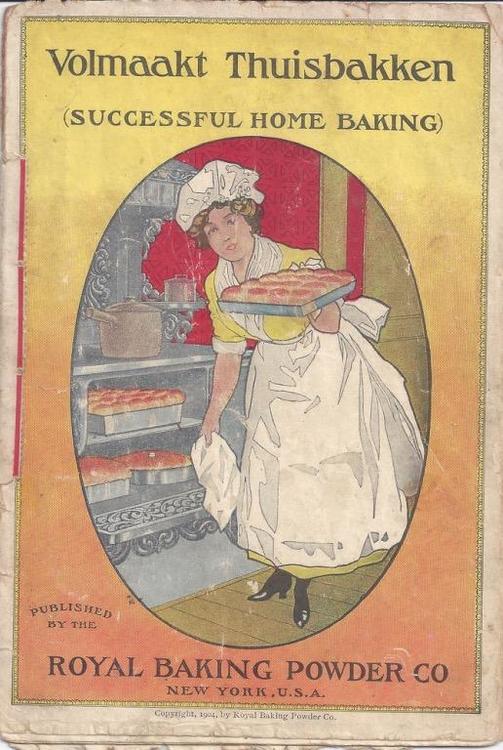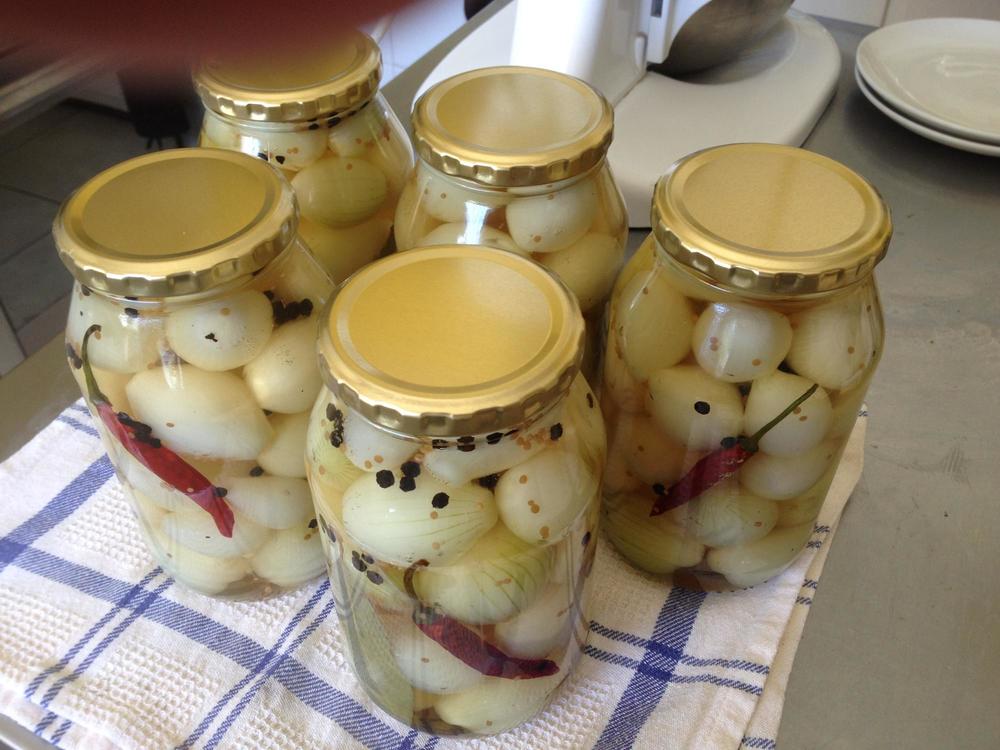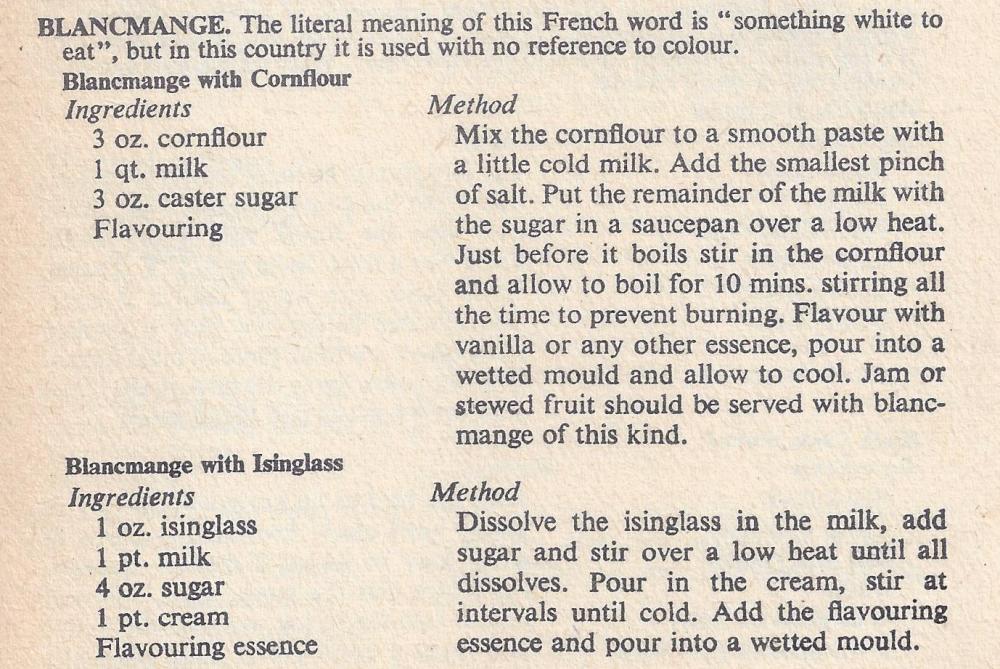-
Posts
542 -
Joined
-
Last visited
Content Type
Profiles
Forums
Store
Help Articles
Everything posted by JohnT
-
Because I make my pizza's very thin, I roll the base to get an even uniformity. My base is about 2mm in thickness. When doing a thicker base, I just hand form it - but it is not often I do a thicker base!
-
It makes a brilliant marinade and then baste for ribs on the BBQ (and most likely ones done in your oven). Do not marinade for too long as it is also a tenderiser.
-
Over the years my mother, who openly admitted that she hated cooking, gifted me a few of her old cookbooks - some a bit scary with the methods used! She recently passed away and I have brought her remaining handwritten and newspaper recipe clippings home to slowly go through. One small booklet I have found was a Royal Baking Powder booklet, in both Dutch and English, printed in the USA in 1904. Why she had it remains a head scratching mystery on my side. She hated baking and, to be truthful, she never baked anything except some biscuits (cookies to those in the Americas) made out of flour, sugar, desicated coconut, raisins, some egg and some form of raising agent. Sometimes they turned out "okay" (in other words just edible), but mostly our Basset Hound would ensure they were removed from sight and never spoken about and about the only time the poor hound was told "good dog". I have scanned it into a PDF file and if anybody wants a copy of it, send me a PM with your email address and I will email it to you.
-
I wonder if the bowl of beans on the package is what is sometimes referred to as a "serving suggestion"
-
What is the green stuff on top?
-
I do like the recipe @Anna N has referred to but I must admit that when I have made sausage rolls using a pork only filling and using it uncooked, I have had too much fat. I used to make quite a few sausage rolls and always, when using just pork for the "sausage" part, changed to cooking the filling first, then when the filling was cooked and cooled down, doing the pastry wrap and bake bit. It resulted in a far less fatty end product but was a bit of a pain due to the time involved. I then changed my filling to a mixture of pork and beef and had far less fat. However, the last batch of sausage rolls I made incorporated added breadcrumbs, and some finely grated vegetables and herbs, which turned out very well. I post the recipe below but have no idea where it actually originates from as it was given to me by an elderly woman at a club I used to do catering for and I never noted her name - she just told me that it came from a relative in Australia. If it did or not, I have no idea but the results were pretty good and tasty – nothing like the run of the mill shop bought ones. SAUSAGE ROLLS Ingredients: 1kg good quality sausages or sausage mince 1 large or two small onions 2 large carrots 2 tablespoons mixed fresh herbs like oregano, marjoram, thyme, sage, parsley (or a good pinch of dried herbs) 1 teaspoon garlic, paste 3 slices of white bread 750g block of cold, ready-made puff pastry - or the ready-rolled stuff if you can spare the expense 1/4 cup poppy seeds (optional) Method: If you bought sausages, push the meat out from the casings into a big bowl and throw the casings away. Finely chop the onions, fresh herbs and garlic. Finely grate the carrots. Add all this to the mince. Whiz the bread up into crumbs using a food processor. Or soak the bread in water for a few minutes, crumble it into the sausage mince and mix the whole lot up really well. The mixture is best left overnight in the fridge to develop its flavour. Preheat the oven to 180°C/350°F. It’s best if you can work with the pastry while it’s still cold and firm. On a floured bench, roll the puff pastry out into 4 rectangles, about 25cm x 12 cm. It’s a bit easier if you bought the ready-rolled puff pastry: just unroll the sheets and cut them in two lengthwise so you have two long, thin rectangles. Lay about a quarter of the mixture in a long, sausage shape about an inch in from the long edge so you have a short flap of pastry near you, and a longer flap away from you. Brush the far edge of the longer flap with water or milk to help it stick. Roll it up, starting with the short flap nearest you. Repeat this until you have four very long sausage rolls. Brush the top with milk and sprinkle the poppy seeds if you’re using them over the top. Cut each long roll into the desired lengths - you can get about 5 or 6 short cocktail-sized sausage rolls out of each long roll, making about 20-25 little sausage rolls in all. Try to slicely through cleanly so you don’t squish the little rolls flat - though it doesn’t matter if you flatten them out a bit. Pop the rolls on a lightly greased oven tray and bake for 20-25 minutes until they’re golden on top and cooked all the way through. Let them cool a bit then either eat them straight away or freeze them ready to reheat later.
-
This is sad news! He was a propper gentleman and fabulous chef with a great passion for promoting the simplicity of the Italian cuisine from the countryside of his homeland. He shall be missed. John.
-
Bunch a few together, stay sober and a short prayer . . . . . Chop . . . . . and repeat if you are not in pain! It's the African way of doing things! I tried chopping the sticky little buggers with my food processor and found that does not work - the dates just spin with the blade. I now have gone off using the biltong slicer (and still have all my fingers) and just mince the things in an electric mincer with a 6mm plate, which gets the job done quickly but then takes ages to clean the mincing machine.
-
Ah, a date chopper/snipper! I go thru around a kilo of dates a week and have to chop them all. I used to use a knife and ended up with blisters after about 500g. Then I reverted to Anna's favourite food "chopper" - a good South African biltong cutter - works brilliantly to chop dates! The blade is a wood plane one - just need to ensure a date is under it and not a finger!
-
This is an annual event in many sub-Sahara countries every spring. It is just that the news media has picked up the Malagasy outbreak this year. It occurs mainly in the slum areas of the main cities and does not affect the outlying countryside and towns. Outbreaks this year have also been reported in Kenya, Tanzania, Burundi, Mozambique, Zimbabwe, Angola and into the DRC. As I say, an annual event with a few hundred people dying each year throughout the region. This may sound bad or my comment trivial, but this is Africa and nobody actually cares very much. Thousands more die each year in tribal fighting and dictators silencing their oppositions. Sad, but true! I am supprised they have not published the South African count this year. It must also be remembered that even the US has around a dozen reported cases each year - all kept relatively quiet by the applicable authorities.
-
Thanks for the reply @cakewalk. That is now the second YT video made by a Turk that says the dough is un-leaven. From the bit of research I have done, it appears that there are regional differences in how they make the dough and the method of cooking it. Let's see if anybody else has some guidance in the making of this so called "street food". The main one I have come across appears to be baby spinach mixed with a bit of onion and feta. Some appear to be cooked on a flat griddle whilst others on a slightly convex cooking iron over an open fire. I found it interesting that I have been to a few small villages and towns in Turkey and never come across gözleme. Other folk I have spoken to have told me they were freely available as street food in the cities. It also appears that they are cut into smaller rectangles and sold with a good squeeze of lemon juice. My SIL, who is visiting from Sydney, says they are all the rave in the street food scene over there and served with a few different fillings - none sweet as I have found on some of my internet searching.
-
Reviving an old topic! I know nothing about gözleme other than what I have been told and the multitude of recipes available on the Internet. I have been to Turkey a couple of times and never come across a gözleme vendor. Most of the recipes on the Internet appear to be a variation of one source in Australia - apparently gözleme are very popular there at the moment and, I am told, they have a large Turkish population. So, I am trying to find a recipe for the dough. The only recipe I have found that actually comes from a Turkish chef, has yeast in the dough. But, I have been told by non-Turkish folk (let's lay my cards on the table - the non-Turkish folk are Australian) that the Turk's do not use yeast! So, my question to those who actually know, is: Is the dough made with yeast or not?!?! I am not looking for a recipe from some cookbook writer who has written a recipe but has never actually been to Turkey or has a recipe "adapted from . . . . .". I am looking for the pukka thing. Any takers?
-
My stock of pickled onions is nearly depleted, so last night I skinned 3 kg of them and this morning they were bottled - 5 x 750ml bottles for putting away for summer.
-
So, I wonder what S.T.E.A.K and L.O.B.S.T.E.R stands for!
-

Your Daily Sweets: What Are You Making and Baking? (2017 – )
JohnT replied to a topic in Pastry & Baking
I am no medical expert and do not pretend to know the actual answer other than it is believed to be responcible or play a large part in obesity, liver and heart disease, dimentia and diabetics. Aparently the corn producing associations in the US have fought hard and long to try and cover-up these problems. I think your best bet is to do your own research and reach your own conclusions. I am led to believe that most European countries have also a ban on corn syrup - maybe some of the EU members on the forum will chime in to confirm or refute this. We are a high maize (corn) producing country and it is illegal to produce corn syrup or even import it. We use glucose or cane syrup as a sub in our products and I have never found any South African recipe that uses corn syrup - even going back to the 1800's. -
That looks very similar to naan! It would go down very well indeed with a small dish of EVOO for dipping whist still hot. And then the medication for overeating and indigestion
-

Your Daily Sweets: What Are You Making and Baking? (2017 – )
JohnT replied to a topic in Pastry & Baking
Thanks pjm333. I see your caramel is quite straight forward. I was adding a half vanilla bean to my caramel and also throwing in a tablespoon of brandy to give it a bit of "spice". I will try your caramel although corn syrup is banned here, so I normall sub it with glucose. My reduction to a 7cm pan would work well here as our apples are a bit on the smaller side as all the good and big ones are exported to Europe and the Asian countries - we get the dregs! -

Your Daily Sweets: What Are You Making and Baking? (2017 – )
JohnT replied to a topic in Pastry & Baking
@pjm333 those mini's look very good! Mind letting me know the diameter of you tarte tatin's? I was experimenting making them a couple of months back but had to put my experiments on pause. I was cooking mine in two stages as the pastry was overdone with the apple not cooked sufficiently. I was using 9cm diameter pans but think 7cm diameter would be a far better size. I must start my experiments again and try and perfect them for bulk baking. -
Anna, you appear to have the same problem as your previous batch of cookies you made that flattened out on you! I would be beating myself over the head with a frying pan if this happened to me a few times. Tell me, what brand of butter are you using? I ask this as in our part of the world there is a butter shortage. Our butter is the same as standard French butter - comes in a 500g brick and is hard out of the fridge. The other day I found a new batch at my supplier and bought a few bricks as it was in a different packaging - one I had not seen before. Fortunately I read the fine print when I arrived home and found that although it was packaged as "butter", it was actually a mixture of vegetable oil and butter "to increase the spreadability", as the fine print said. Totally useless for baking! I was wondering if your butter may not be pure and is softened somehow with an addition of vegetable oil or something else to make it run as soon as it is subject to heat. I returned mine to the supplier.
-

Your Daily Sweets: What Are You Making and Baking? (2017 – )
JohnT replied to a topic in Pastry & Baking
Okay, I found my study notes and the method using ground almonds is quite complicated and appears outdated. However, I found in "Nell Heaton's Cooking Dictionary", which contains no publishing date or copyright but has my mothers note that she was given the book in what appears to be 1948, the following two recipes for "Blancmange": -

Your Daily Sweets: What Are You Making and Baking? (2017 – )
JohnT replied to a topic in Pastry & Baking
Well, I was always taught that it was a sweet almond gelatinised dessert, made with ground almonds/almond milk and gelatine! I will have to go through my old books and study notes to see if my memory is buggered or still reasonably okay! But then, the modern instant pudding manufactures will surely have come up with a modern version made without gelatine and using cornstarch or some other powder to thicken a mixture. -
Anna, you are most probably correct - or I hope you are. The confusing part is that an oxtail has around 12 "vertebrae" and a tail does weigh around 1.25 to 1.5 lb. The ad should then read 15lb oxtail in 12 portioned packs each weighing 1.25 to 1.5 lb. As the ad stands, it is quite confusing to me. Anyway, I hope that whoever purchases some of those packs trims off the excess fat before cooking it up - the photo does show you would be buying a lot of very expensive fat! But that is something different - I still love oxtail in both a soup or slow-cooked form, but find it way too expensive.
-
@lindag I think you (or I) have misread the quantity! The ad says 1.25 to 1.5 pound (note the "point") and not 15 pounds. This, from what I gather, is $200.00 for one (1) tail. At that price I doubt they sell many of them! Here in my city and at my butcher they are also bloody expensive at around Rand 200.00 + per tail, which equates to about $15 + for a tail and is definitely way more expensive than a prime beef fillet. The days of purchasing a tail, for me at least, are way in the past. However, the other day I purchased two lamb shanks at a cost of around $13 and had a magnificent meal with left-overs for sandwiches the next day. I equate lamb shanks to oxtail in flavour and tenderness when properly cooked - both have that high intense flavour and aroma!
-
Bong! Bump . . . . Cheese Burgers or Cheeseburgers Okay, here is the truth. I am a great cheese lover of real cheese - but do not like it melted on a burger! I have had a few "cheeseburgers" and always found the cheese like a slab of plastic melted on a good quality beef patty (other than those produced by the fast food outlets - the quality beef part that is). What is the point? I recently read a write-up by some fella named Chris Thompson who proclaimed that chefs (burger flippers) are doing their assembly all wrong! The article is here. Other than his method of assembly, the "cheese" square used in South Africa (and on two occasions in the US) appears to be a "processed cheese", in other words a slab of cheese looking, and flavoured, plastic! So my question is not really about the above article, but what cheese do you eG folk use when making a cheeseburger? Grated cheddar or Gouda? Swiss? Blue? Other? Any other comment would also be appreciated as I want to bang out a couple of cheese burgers in the next day or two and do some experimenting to see if I can come up with something half- decent and edible!
-
@David RossThat is a fine looking crumb structure for a Ciabatta. Your hydration is very high and, together with the long rising time, you really are making a Ciabatta! Great loaf!







